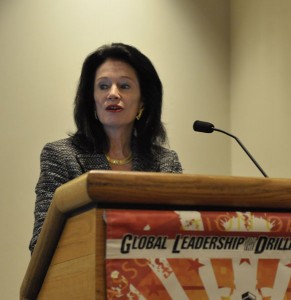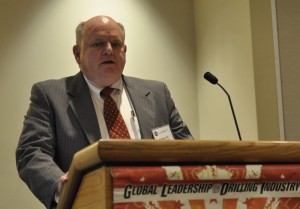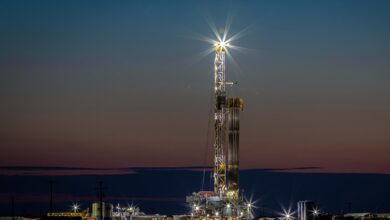Forecast: Shale oil, gas may make US world’s top producer by 2020
By Joanne Liou, editorial coordinator

Given shale activity that far exceeds countries around the world, compounded with the growth in deepwater markets, the US is on track to overtake Russia and Saudi Arabia as the largest producer in the world by 2020, according to Susan Farrell, senior director at PFC Energy. Ms Farrell and George Littell, partner at Groppe, Long & Littell, shared insight into market plays that are shifting the industry on a path of steady growth at the 2011 IADC Annual General Meeting in Austin, Texas, last week.
Considering the state of the global economy, Ms Farrell suggested that there are two scenarios for the next few years. “We have the base case, which is the best case, where we’re going to continue to be in a two-track world,” she explained. “We’ll have the Asian countries, who will continue along to about 10% GDP (growth) this year, dropping down to 8% over the next couple of years. The US and Eurozone economies are declining in 2011 (to about 2% growth).”
The second scenario is another recession. “Europe will be in recession, but the question is whether the financial crisis repeats itself,” Ms Farrell said, adding that a second recession in the US wouldn’t be as bad as the first. However, with economies still weak from the first recession, getting out of a second fall would be difficult. “In 2008, the feds fund rate was 4.25%. You had that tool; you could lower the rate, but now it’s almost zero.”
Zooming in on oil and gas markets, the tides continue to turn between emerging and older markets. “Global oil demand for (countries in) the OECD (Organization for Economic Cooperation and Development) has been declining since 2006,” Ms Farrell said, pointing out that the reason global oil demand is rising is because demand in non-OECD markets counterbalances that decline. By 2013, PFC Energy forecasts OECD and non-OECD oil demands to be equal.
The natural gas markets project a similar path. “In 2006, emerging markets’ consumption was higher than the older markets’ consumption, and it continued up. This market had a different reaction to the recession,” Ms Farrell said. “In fact, it was a ‘V’ recession; it went down and came back up on track.”
In regards to oil prices, there’s a strong consensus among OPEC that prices need to remain about $90 to $100 per barrel to balance rising costs and political turmoil, Ms Farrell said, and there is a need for OPEC to cut back on production next year. She believes Saudi Arabia will cut back as they did in 2008. “Most global gas prices are oil linked,” Ms Farrell said, and depending on the way you look at the market, gas prices could be good or they could be bad. “For most of the LNG world, LNG prices are good. In the US, prices are really low, and it’s because of gas competition. In the UK, it’s in between, and it’s because the demand is low.” UK gas production has dropped significantly, resulting in both lower demand and lower supply.
Investments in E&P for the top 20 IOCs and top 20 NOCs account for about 75% of total E&P spending, which amounted to more than $500 billion onshore and offshore. “How companies look at the world and where they decide to put their investments is a great import when making drilling decisions,” Ms Farrell said. “When you look at the type of prices OPEC says they need, those are prices with today’s cost structure, which are competitive and which will attract investment.” The high oil prices are driving operators to pursue growth from all types of plays.

In the US, shale started taking off after a dip in production in 2006. An increase in both shale oil and shale gas will continue to boost US total production. Putting the spotlight on US production numbers in comparison to other markets, the US is producing more natural gas than Russia in 2011 and is inching closer to Russia’s total production, which includes oil, gas and gas liquids. “By 2020, the US is going to be rivaling Russia as the largest single country producer in the world in oil and gas combined,” Ms Farrell said. “The reason we’re able to do that is because of shale oil and shale gas.”
In a study of well productivity, Ms Farrell said that production is highly skewed. “We drill about 1,000 (shale gas) wells a month, take the best 100 wells, the second-best 100 wells, and we put them in tiers of 100,” she explained. “If you take the top three tiers, the top 300 wells of 1,000, they account for 70% of production.” Given the tiers, a company can theoretically reduce drilling without much impact on production, if the company knows where their best wells are.
In the past three years, the US has drilled more than 15,000 shale-gas wells. The next-biggest country is Canada at 170, and all other countries have drilled only 10 to 15 wells. “In terms of the scale of activity, which is required to generate the type of production which we’re forecasting, you don’t have anything like that started in the rest of the world. Not that it won’t come, but it’s not something that is going to happen five years from now.”
Mr Littell pointed out the potential in Iraq oil production. “Over the last two years, the oil ministry of Iraq has concocted a plan and signed up to 14 different agreements to develop Iraq’s oil production,” he said. In a scenario without any limitations or roadblocks, “the projected plan takes Iraq from being a producer of a little over 2 million bbl/day to a producer of 10 million bbl/day in seven years.”
In the realm of natural gas, Mr Littell describes a bleak story of a steadily declining shallow-water industry in the Gulf of Mexico that is typically overshadowed by oil. The initial production of natural gas began in 1947, and “it took 24 years to get up to 15.3 bcfd, which was the initial peak in 1981. The second gas peak of 15.5 bcfd was in 1997, and it has been a long slide (down) since. Last year, the Gulf averaged a little over 6.5 bcfd.”




